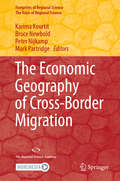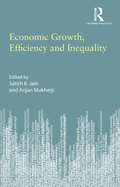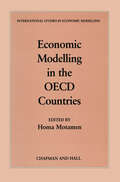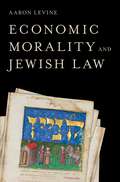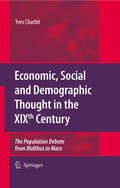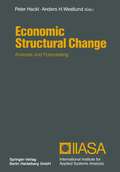- Table View
- List View
The Economic Geography of Cross-Border Migration (Footprints of Regional Science)
by Karima Kourtit Bruce Newbold Peter Nijkamp Mark PartridgeThis handbook presents a collection of high-quality, authoritative scientific contributions on cross-border migration, written by a carefully selected group of recognized migration experts from around the globe. In recent years, cross-border migration has become an important and intriguing issue, from both a scientific and policy perspective. In the ‘age of migration’, the volume of cross-border movements of people continues to rise, while the nature of migration flows – in terms of the determinants, length of stay, effects on the sending and host countries, and legal status of migrants – is changing dramatically. Based on a detailed economic-geographical analysis, this handbook studies the motives for cross-border migration, the socio-economic implications for sending countries and regions, the locational choice determinants for cross-border migrants, and the manifold economic-geographic consequences for host countries and regions. Given the complexity of migration decisions and their local or regional impacts, a systematic typology of migrants (motives, legal status, level of education, gender, age, singles or families, etc.) is provided, together with an assessment of push factors in the place of origin and pull factors at the destination. On the basis of a solid analytical framework and reliable empirical evidence, it examines the impacts of emigration for sending areas and of immigration for receiving areas, and provides a comprehensive discussion of the policy dimensions of cross-border migration.
Economic Growth: Theory and Numerical Solution Methods (Springer Texts in Business and Economics)
by Alfonso Novales Esther Fernández Jesús RuizThis is a book on deterministic and stochastic Growth Theory and the computational methods needed to produce numerical solutions. Exogenous and endogenous growth models are thoroughly reviewed. Special attention is paid to the use of these models for fiscal and monetary policy analysis. Modern Business Cycle Theory, the New Keynesian Macroeconomics, the class of Dynamic Stochastic General Equilibrium models, can be all considered as special cases of models of economic growth, and they can be analyzed by the theoretical and numerical procedures provided in the textbook.Analytical discussions are presented in full detail. The book is self contained and it is designed so that the student advances in the theoretical and the computational issues in parallel. EXCEL and Matlab files are provided on an accompanying website (see Preface to the Second Edition) to illustrate theoretical results as well as to simulate the effects of economic policy interventions. The structure of these program files is described in "Numerical exercise"-type of sections, where the output of these programs is also interpreted. The second edition corrects a few typographical errors and improves some notation.
Economic Growth: Theory and Numerical Solution Methods (Springer Texts in Business and Economics)
by Alfonso Novales Esther Fernández Jesús RuizThis is the third corrected and extended edition of a book on deterministic and stochastic Growth Theory and the computational methods needed to produce numerical solutions. Exogenous and endogenous growth, non-monetary and monetary models are thoroughly reviewed. Special attention is paid to the use of these models for fiscal and monetary policy analysis. Models under modern theories of the Business Cycle, New Keynesian Macroeconomics, and Dynamic Stochastic General Equilibrium models, can be all considered as special cases of economic growth models, and they can be analyzed by the theoretical and numerical procedures provided in the textbook.Analytical discussions are presented in full detail. The book is self-contained and it is designed so that the student advances in the theoretical and the computational issues in parallel. Spreadsheets are used to solve simple examples. Matlab files are provided on an accompanying website to illustrate theoretical results from all chapters as well as to simulate the effects of economic policy interventions. The logical structure of these program files is described in "Numerical exercise"-type of sections, where the output of these programs is also interpreted. The third edition corrects a few typographical errors, includes two new and original chapters on frequentist and Bayesian estimation, and improves some notation.
Economic Growth: Theory and Numerical Solution Methods
by Alfonso Novales Esther Fernández Jesús RuízThis is a book on deterministic and stochastic Growth Theory and the computational methods needed to produce numerical solutions. Exogenous and endogenous growth models are thoroughly reviewed. Special attention is paid to the use of these models for fiscal and monetary policy analysis. Modern Business Cycle Theory, the New Keynesian Macroeconomics, the class of Dynamic Stochastic General Equilibrium models, can be all considered as special cases of models of economic growth, and they can be analyzed by the theoretical and numerical procedures provided in the textbook. Analytical discussions are presented in full detail. The book is self contained and it is designed so that the student advances in the theoretical and the computational issues in parallel. EXCEL and Matlab files are provided on an accompanying website to illustrate theoretical results as well as to simulate the effects of economic policy interventions.
Economic Growth and the Middle Class in an Economy in Transition: The Case of Russia (Economic Studies in Inequality, Social Exclusion and Well-Being)
by Zoya NissanovThis book studies the evolution of the middle class in Russia after the fall of the Soviet Union. Using data from the RLMS (Russian Longitudinal Monitoring Survey), the volume covers the period of transition (1991-2008) during which many fundamental economic reforms were implemented. The first part of the book is devoted to a discussion of the concept of middle class and a description of the economic situation in Russia during the transition period. Particular attention is given to variations in the distribution of Russian incomes and the estimated importance of the middle class. The second part of the book focuses on the link between the middle class and income bipolarization. The third and last section of the book uses the semiparametric "mixture model" to discover how many different groups may be derived from the income distribution in Russia, as well as what the main socio-economic and demographic characteristics of those groups are. The mobility of households into and out of the middle class during the transition period is also studied in hopes of determining the factors that contribute to such mobility. Using rigorous empirical methods, this volume sheds light on a relatively unstudied economic group and provides insight for countries which are about to enter a transition period. As such, this book will be of great interest to researchers in economics and inequality as well as professionals and practitioners working with international organizations.
Economic Growth, Efficiency and Inequality
by Satish K. Jain Anjan MukherjiThis volume deals with a range of contemporary issues in Indian and other world economies, with a focus on economic theory and policy and their longstanding implications. It analyses and predicts the mechanisms that can come into play to determine the function of institutions and the impact of public policy.
Economic Growth, Efficiency and Inequality
by Satish K. Jain Anjan MukherjiThis volume deals with a range of contemporary issues in Indian and other world economies, with a focus on economic theory and policy and their longstanding implications. It analyses and predicts the mechanisms that can come into play to determine the function of institutions and the impact of public policy.
Economic Hierarchies, Organization and the Structure of Production (Studies in Public Choice #7)
by G. TullockEconomics has been basically a study of the interactions between organizations, with some organizations being so small we only have one person in them. The internal organization of the largest hierarchies has indeed been looked at, but a good reason for working less on these organizations is that the internal reactions are much harder to understand. It is sensible to solve the problems we can solve and put the others off until later. The author's basic purpose here is to look at these larger hierarchical organizations, and develop a scientific account of them. In Economic Hierarchies, Organization and the Structure of Production Gordon Tullock examines the internal functioning and organization of the corporation. In the author's personal tradition, the book relies on narrative analysis rather than mathematical complexity to convey insights into the functioning of the corporation.
An Economic History of British Steam Engines, 1774-1870: A Study on Technological Diffusion (Contributions to Economics)
by Haris KitsikopoulosThis book traces the diffusion trajectory of the second and third generation of British steam engines, the Watt and high-pressure models, covering the period 1774 to 1870. It begins by subjecting to econometric analysis the latest version of Dr. Kanefsky's database on 18th century steam engines coming up with an upward revision of the total amount of horsepower installed by 1800. Subsequent chapters delve into the determinants of the diffusion process through the third quarter of the 19th century relating to engines used both in mining and industry as well as transportation (railways, steam cars). The book's main contribution to the literature lies in drawing material from a very large volume of 18th- and 19th-century sources found in the Dibner Library of Rare Books, Smithsonian, and by utilizing a fair amount of technical literature pertaining to the economic factors driving the diffusion process. This great expansion of the empirical material has led to bringing multiple revisions to the work of other authors on the key aspects and determinants of the diffusion process. In conjunction with the publication by the author of an earlier monograph on the first generation of steam engines, the Newcomen model, the present study completes the task of offering the most comprehensive account of the preeminent and most strategic technology of the British Industrial Revolution. This book will appeal to students, scholars, and researchers of economic history and history of technology, interested in a better understanding of the industrial revolution in general and the role of British steam engines in particular.
An Economic Interpretation of Linear Programming
by Quirino ParisThis text covers the basic theory and computation for mathematical modeling in linear programming. It provides a strong background on how to set up mathematical proofs and high-level computation methods, and includes substantial background material and direction. Paris presents an intuitive and novel discussion of what it means to solve a system of equations that is a crucial stepping stone for solving any linear program. The discussion of the simplex method for solving linear programs gives an economic interpretation to every step of the simplex algorithm. The text combines in a unique and novel way the microeconomics of production with the structure of linear programming to give students and scholars of economics a clear notion of what it means, formulating a model of economic equilibrium and the computation of opportunity cost in the presence of many outputs and inputs.
The Economic Lifecycle, Gender and Intergenerational Support: National Transfer Accounts for Italy (SpringerBriefs in Population Studies)
by Marina ZannellaThis book examines economic transfers across generations and genders from a European perspective. It addresses key challenges that contemporary societies face in regards to ageing, welfare sustainability, and intergenerational and gender equity. Coverage also offers important insights into an often invisible side of the economy, namely the contribution of women who because of the gender contract largely engage in unpaid work in the household. The book presents a detailed analysis of resource reallocation across population members in Italy, which encompasses the age and the gender perspective, the public and the private sector, and the market and non-market dimensions of the Italian economy. This innovative and comprehensive case study presents valuable information on how intergenerational obligations are split between the family and the state. The author also explores the possible economic consequences of future ageing by using demographic projections and estimated age profiles of production and consumption. By incorporating services originating from unpaid work in its analysis, this monograph corrects the traditional under-evaluation of the ways homemakers contribute to the economy and offers an important addition to studies on generational economy, the National Transfer Accounts project in particular. The methods presented inside, though using data specific to Italy, are relevant for all European countries and will appeal to readers with an interest in welfare studies and policies.
Economic Miracles in the European Economies
by Magdalena OsińskaThis book undertakes a theoretical and econometric analysis of intense economic growth in selected European countries during the end of the twentieth century and the beginning of the twenty first. Focusing on the accelerated economic growth that occurred in Ireland, the Netherlands, Spain, and Turkey, this book investigates the determinants and consequences of this “miracle” growth and discusses them in context of growth and development processes observed in European market-type economies after the World War II. Using imperfect knowledge economics (IKE) as a theoretical framework to interpret the empirical results, this book provides a fresh theoretical perspective in comparison with current Neo-classical, Keynesian and institutional paradigms. With this systematic approach, the authors seek to provide a unified methodology for evaluating the phenomenon of intense economic growth that has heretofore been missing from the discipline. Combining diverse theoretical and methodological strategies to provide a holistic understanding of the historical process of economic change, this volume will be of interest to students and scholars of economic growth, econometrics, political economy, and the new institutional economics as well as policymakers.
Economic Modeling and Inference
by Bent Jesper Christensen Nicholas M. KieferEconomic Modeling and Inference takes econometrics to a new level by demonstrating how to combine modern economic theory with the latest statistical inference methods to get the most out of economic data. This graduate-level textbook draws applications from both microeconomics and macroeconomics, paying special attention to financial and labor economics, with an emphasis throughout on what observations can tell us about stochastic dynamic models of rational optimizing behavior and equilibrium. Bent Jesper Christensen and Nicholas Kiefer show how parameters often thought estimable in applications are not identified even in simple dynamic programming models, and they investigate the roles of extensions, including measurement error, imperfect control, and random utility shocks for inference. When all implications of optimization and equilibrium are imposed in the empirical procedures, the resulting estimation problems are often nonstandard, with the estimators exhibiting nonregular asymptotic behavior such as short-ranked covariance, superconsistency, and non-Gaussianity. Christensen and Kiefer explore these properties in detail, covering areas including job search models of the labor market, asset pricing, option pricing, marketing, and retirement planning. Ideal for researchers and practitioners as well as students, Economic Modeling and Inference uses real-world data to illustrate how to derive the best results using a combination of theory and cutting-edge econometric techniques.Covers identification and estimation of dynamic programming models Treats sources of error--measurement error, random utility, and imperfect control Features financial applications including asset pricing, option pricing, and optimal hedging Describes labor applications including job search, equilibrium search, and retirement Illustrates the wide applicability of the approach using micro, macro, and marketing examples
Economic Modeling of Water: The Australian CGE Experience (Global Issues in Water Policy #3)
by Glyn WittwerThe book details the innovative TERM (The Enormous Regional Model) approach to regional and national economic modeling, and explains the conversion from a comparative-static to a dynamic model. It moves on to an adaptation of TERM to water policy, including the additional theoretical and database requirements of the dynamic TERM-H2O model. In particular, it examines the contrasting economic impacts of water buyback policy and recurring droughts in the Murray-Darling Basin. South-east Queensland, where climate uncertainty has been borne out by record-breaking drought and the worst floods in living memory, provides a chapter-length case study. The exploration of the policy background and implications of TERM’s dynamic modeling will provide food for thought in policy making circles worldwide, where there is a pressing need for solutions to similarly intractable problems in water management.
Economic Modeling Using Artificial Intelligence Methods (Advanced Information and Knowledge Processing)
by Tshilidzi MarwalaEconomic Modeling Using Artificial Intelligence Methods examines the application of artificial intelligence methods to model economic data. Traditionally, economic modeling has been modeled in the linear domain where the principles of superposition are valid. The application of artificial intelligence for economic modeling allows for a flexible multi-order non-linear modeling. In addition, game theory has largely been applied in economic modeling. However, the inherent limitation of game theory when dealing with many player games encourages the use of multi-agent systems for modeling economic phenomena.The artificial intelligence techniques used to model economic data include:multi-layer perceptron neural networksradial basis functionssupport vector machinesrough setsgenetic algorithmparticle swarm optimizationsimulated annealingmulti-agent systemincremental learningfuzzy networksSignal processing techniques are explored to analyze economic data, and these techniques are the time domain methods, time-frequency domain methods and fractals dimension approaches. Interesting economic problems such as causality versus correlation, simulating the stock market, modeling and controling inflation, option pricing, modeling economic growth as well as portfolio optimization are examined. The relationship between economic dependency and interstate conflict is explored, and knowledge on how economics is useful to foster peace – and vice versa – is investigated. Economic Modeling Using Artificial Intelligence Methods deals with the issue of causality in the non-linear domain and applies the automatic relevance determination, the evidence framework, Bayesian approach and Granger causality to understand causality and correlation.Economic Modeling Using Artificial Intelligence Methods makes an important contribution to the area of econometrics, and is a valuable source of reference for graduate students, researchers and financial practitioners.
Economic Modelling in the OECD Countries (International Studies in Economic Modelling)
by Homa Motamen-Scobieamong the 159 member countries of the United Nations Organization which are treated as country units, while smaller countries are grouped together in regions. The number of equations used is approximately 13 700, while the number of software steps for computation is approximately 100000. Computation, including tabulation, can nevertheless be performed very rapidly, and only about 20 minutes is required to make forecasts from the present up to the year 2000. The FUGI model is at present being used by the Projections and Perspectives Studies Branch, Department of International Economic and Social Affairs of the United Nations, for simulations of United Nations medium- and long-term international development strategies, while the Project LINK model is being used for short-term forecasts (Onishi, 1985). Stimulated by our latest joint research with the United Nations University on a 'global early warning system for displaced persions', we have felt the need for our FUGI model to go beyond its present capacities centred on an 'economic' model (in the rather traditional, restricted sense of the term) and to develop into a model that can in the future analyse 'global problematiques' or 'global complexes of symptoms' and complicated questions including various types of environmental problems and the sorts of displaced persons issues to which we are now directing our attention. We are thus expanding the scope of our fifth-generation FUGI model, presently under development, to deal with such issues.
Economic Models, Estimation and Risk Programming: Essays in Honor of Gerhard Tintner (Lecture Notes in Economics and Mathematical Systems #15)
by K. A. Fox J. K. Sengupta G. V. L. NarasimhamThese essays in honor of Professor Gerhard Tintner are substantive contributions to three areas of econometrics, (1) economic models and applications,. (2) estimation, and (3) stochastic programming, in each of which he has labored with outstanding success. His own work has extended into multivariate analysis, the pure theory of decision-making under un certainty, and other fields which are not touched upon here for reasons of space and focus. Thus, this collection is appropriate to his interests but covers much less than their full range. Professor Tintner's contributions to econometrics through teaching, writing, editing, lecturing and consulting have been varied and inter national. We have tried to highlight them in "The Econometric Work of Gerhard Tintner" and to place them in historical perspective in "The Invisible Revolution in Economics: Emergence of a Mathematical Science. " Professor Tintner's career to date has spanned the organizational life of the Econometric Society and his contributions have been nearly coextensive with its scope. His principal books and articles up to 1968 are listed in the "Selected Bibliography. " Professor Tintner's current research involves the intricate problems of specification and application of stochastic processes to economic systems, particularly to growth, diffusion of technology, and optimal control. As always, he is moving with the econometric frontier and a portion of the frontier is moving with him. IV Two of the editors wrote dissertations under Professor Tintner's sup- vision; the third knew him as a colleague and friend.
Economic Models of Trade Unions (International Studies in Economic Modelling)
by P. Garonna P. Mori P. TedeschiOver the 1980s unions have lost about 5 million members in OECD countries. The proportion of unionized workers is increasing in the services, public sector and among women. Today, almost two out of five union members are employed in the public sector. Wide differences remain in the levels of unionization in diverse countries, while in the United States, France and Spain union members account now for little more than 10% of the labour force, in the Nordic countries (Sweden, Finland and Denmark) the corre'sponding figure is between 75 and 85%. In general, rates have been higher in Europe than in North America. Economic analysis is paying increasing attention to these developments and to their policy implications (Edwards, Caronna and Todling, OCDE 1991). Recent progress in economic theory has enabled some light to be cast on the determinants of unionism, on the other hand, efforts aimed at coming to grips with the economic reality of unions have significantly contributed to theoretical advancement by extending and modifying conventional microeconomic wisdom. The reader of this volume will judge whether the insight gained is sufficient, or - as a recent survey concluded ~ the problem has proved to be virtually intractable (Johnson, p. 24). These can be grouped under three headings, corresponding to the three parts of the volume, which will be illustrated in the Introduction.
Economic Morality and Jewish Law
by Aaron Levine (1946-2011)Economic Morality and Jewish Law compares the way in which welfare economics and Jewish law determine the propriety of an economic action, whether by a private citizen or the government. Espousing what philosophers would call a consequentialist ethical system, welfare economics evaluates the worthiness of an economic action based on whether the action would increase the wealth of society in the long run. In sharp contrast, Jewish law espouses a deontological system of ethics. Within this ethical system, the determination of the propriety of an action is entirely a matter of discovering the applicable rule in Judaism's code of ethics. This volume explores a variety of issues implicating morality for both individual commercial activity and economic public policy. Issues examined include price controls, the living wage, the lemons problem, short selling, and Ronald Coase's seminal theories on negative externalities. To provide an analytic framework for the study of these issues, the work first delineates the normative theories behind the concept of economic morality for welfare economics and Jewish law, and presents a case study illustrating the deontological nature of Jewish law. The book introduces what for many readers will be a new perspective on familiar economic issues. Despite the very different approaches that welfare economics and Jewish law take in evaluating the worthiness of an economic action, the author reveals a remarkable symmetry between the two systems in their ultimate prescriptions for certain economic issues.
Economic Morality and Jewish Law
by Aaron Levine (1946-2011)Economic Morality and Jewish Law compares the way in which welfare economics and Jewish law determine the propriety of an economic action, whether by a private citizen or the government. Espousing what philosophers would call a consequentialist ethical system, welfare economics evaluates the worthiness of an economic action based on whether the action would increase the wealth of society in the long run. In sharp contrast, Jewish law espouses a deontological system of ethics. Within this ethical system, the determination of the propriety of an action is entirely a matter of discovering the applicable rule in Judaism's code of ethics. This volume explores a variety of issues implicating morality for both individual commercial activity and economic public policy. Issues examined include price controls, the living wage, the lemons problem, short selling, and Ronald Coase's seminal theories on negative externalities. To provide an analytic framework for the study of these issues, the work first delineates the normative theories behind the concept of economic morality for welfare economics and Jewish law, and presents a case study illustrating the deontological nature of Jewish law. The book introduces what for many readers will be a new perspective on familiar economic issues. Despite the very different approaches that welfare economics and Jewish law take in evaluating the worthiness of an economic action, the author reveals a remarkable symmetry between the two systems in their ultimate prescriptions for certain economic issues.
Economic Policy of the People's Republic of China
by Barbara DarimontThis book deals with the current economic policy of the People's Republic of China. In addition to a brief overview of economic history since its founding and discussions of economic models, an overview of both the forms of business and the Chinese labor market is provided. The book pays particular attention to the development of China's e-commerce sector. Equally significant are China's environmental issues against the backdrop of the climate crisis. Without innovations, for example in energy production and waste management, the Chinese economy will hardly be able to continue growing. Therefore, one focus of the book is on economic policy in the environmental sector. Finally, foreign policy, including the Silk Road Initiative, is examined. The aim of this book is to highlight the above developments. It is aimed at laypersons involved in the business of China as well as first-year students who want an overview of economic policy institutions and current developments.
Economic Progress and Growth (Exlog Series of Petroleum Geology and Engineering Handbooks)
by H.M. ScobieThis volume puts forward a group of models applied to different economies, capturing the progress and growth of their economic systems. The models provide a quantified framework for the formulation of economic policy. They aid the introduction of targets and policy instruments taking account of constraints in the process of development. Also, an evaluation of external and internal shocks is taken using a comparative static type of analysis. The models take into account constraints which are in the nature of institutional as well as supply constraints. Problems of data exist in any quantitative analysis and account was taken of this factor in presenting the models and the results reached. Nonetheless, the models attempt to specify, estimate and simulate a given macroeconomic system. Models of this type are not freely available to the interested reader, but only in a fragmented way. This book puts the efforts of a group of economists worldwide under one cover. It is believed that the collection will be of interest both for courses in planning and for those adviSing these countries such as international organizations, research bodies, etc. Moreover, an overview of trade policy and income distributional factors is presented. It is hoped that this collection will prove interesting and useful to economists world wide.
The Economic Reason: A Piecemeal Guide to Your Inner Homo Economicus
by Shane SandersIn a series of conversational essays, this textbook discusses the manner in which economic thought addresses a broad array of everyday issues beyond classical textbook treatments. In the spirit of popular economics books, the author uncovers economic issues and solutions from individuals, businesses, society, and the country as a whole in a decidedly non-technical and relatable manner. Should the federal government mandate use of child safety seats on commercial airlines? Can genetic information substitute for a college degree? The contents of this book touch on many of these contemporary topics in an accessible way. Addressing undergraduate and graduate students, as well as scholars in different fields of economics, this book is a must-read for everybody interested in a better understanding of economic thought.
Economic, Social and Demographic Thought in the XIXth Century: The Population Debate from Malthus to Marx
by Yves CharbitAccording to current understanding, Malthus was hostile to an excess of population because it caused social sufferings, while Marx was favourable to demographic growth in so far as a large proletariat was a factor aggravating the contradictions of capitalism. This is unfortunately an oversimplification. Both raised the same crucial question: when considered as an economic variable, how does population fit into the analysis of economic growth? Even though they started from the same analytical standpoint, Marx established a very different diagnosis from that of Malthus and built a social doctrine no less divergent. The book also discusses the theoretical and doctrinal contribution of the liberal economists, writing at the onset of the industrial revolution in France (1840-1870), and those of their contemporary, Pierre-Joseph Proudhon, who shared with Marx the denunciation of the capitalist system. By paying careful attention to the social, economic, and political context, this book goes beyond the shortcomings of the classification between pro- and anti-populationism. It sheds new light over nineteenth century controversies over population in France, a case study for Europe.
Economic Structural Change: Analysis and Forecasting
by Peter Hackl Anders H. WestlundStructural change is a fundamental concept in economic model building. Statistics and econometrics provide the tools for identification of change, for estimating the onset of a change, for assessing its extent and relevance. Statistics and econometrics also have de veloped models that are suitable for picturing the data-generating process in the presence of structural change by assimilating the changes or due to the robustness to its presence. Important subjects in this context are forecasting methods. The need for such methods became obvious when, as a consequence of the oil price shock, the results of empirical analyses suddenly seemed to be much less reliable than before. Nowadays, economists agree that models with fixed structure that picture reality over longer periods are illusions. An example for less dramatic causes than the oil price shock with similarly profound effects is economic growth and its impacts on the economic system. Indeed, economic growth was a motivating concept for this volume. In 1983, the International Institute for Applied Systems Analysis (IIASA) in Laxen burg/ Austria initiated an ambitious project on "Economic Growth and Structural Change".
